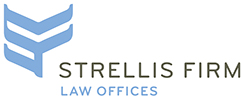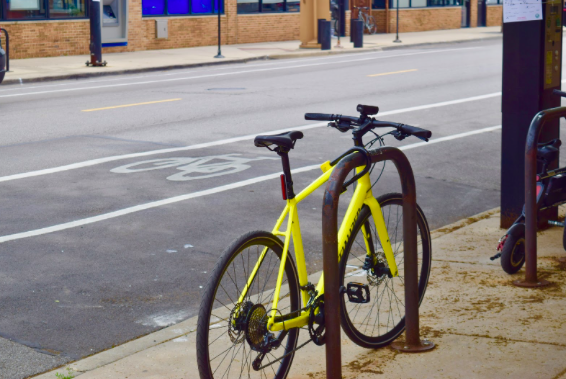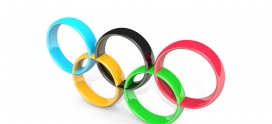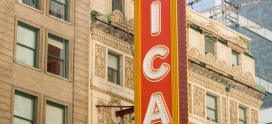Essential Tips to Avoid a Cycling Accident
Chicago’s lakefront is dotted with cyclists throughout the year, but in the summer, our streets and paths flood with two-wheeled travelers. Since cycling is one of the most affordable, efficient and enjoyable modes of transportation, tons of Chicagoans rely on their bicycles to get them from point A to point B.
The city of Chicago boasts over 200 miles of protected bike paths and that number is only growing. Mayor Emanuel has announced plans to make Chicago America’s hub for cyclists. In 2016, he debuted an initiative to expand the city’s bike route network 50 miles by 2020.
Cyclists are more likely to be injured or in an accident, so before you take to the streets on your Schwinn, check out this cyclist safety guide from Strellis & Field:
Avoid a Cycling Accident With These 9 Tips
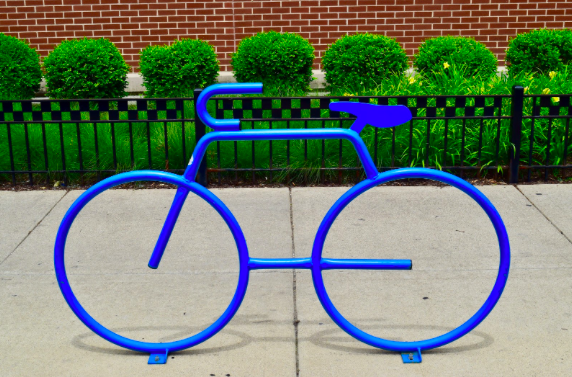
1. Stay in Your Lane
Cyclist-friendly lanes are not only for convenience, but also for safety. Drivers are anticipating your presence within the boundaries of the bike lane, so it is best to stay in designated bike lanes to avoid being eclipsed by a driver’s blind spot. Try to avoid weaving in and out of traffic. The dexterity of biking can make it tempting to weave in and out of traffic, but for the safety of yourself and others, it should be avoided. Lastly, stay off of sidewalks. Some bikers take solace from the hectic roadways by biking on the sidewalk, but sidewalk cycling is illegal in the city of Chicago because it poses a threat to the pedestrian foot traffic.
If sharing the road with other motorists isn’t your thing, Chicago has you covered. The 606 trail is essentially a transit loop exclusively for pedestrian and bike traffic. Stretching almost 3 miles, the 606 offers Chicago residents a cycling highway alternative to on-street bike lanes.
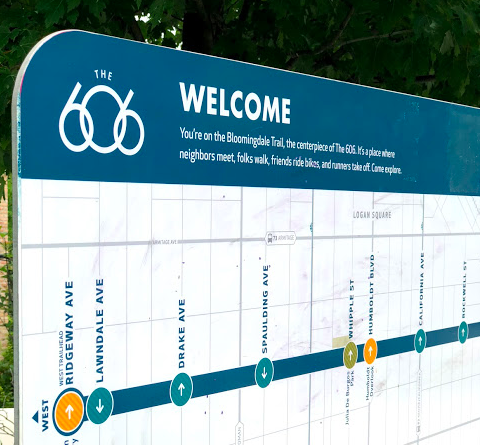
2. Go with the Flow
This tip may seem obvious to experienced cyclists, but it is worth being said. As a biker, you are more akin to a vehicle than a pedestrian. As a result, you need to make sure you follow the direction of motorist traffic and ride on the right hand side of the road.
3. Act Like a Car
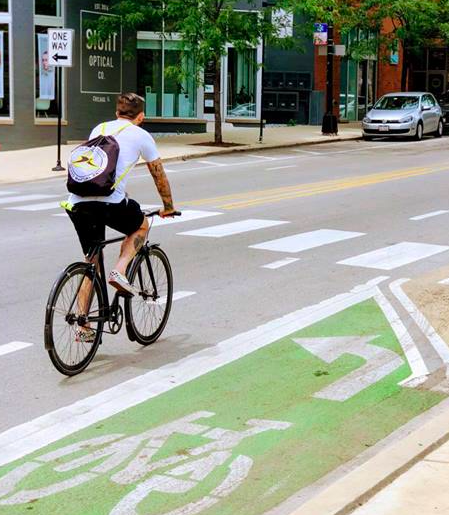
Although bikes have their own distinct traffic lanes, it is important to remember that cyclists are not exempt from the rules of the road. Take care to signal to other motorists and bicyclists when you are turning, halt at stop signs, and pause for pedestrian traffic. Though operating a bicycle does not require a license, cyclists are still subject to traffic laws. Very often, bikers will roll through stop signs or bike in the opposite direction of one-way traffic. These practices are dangerous to the cyclists, themselves, as well as the surrounding motorists. Riding predictably and abiding by traffic laws helps to keep everyone safe.
4. Don’t Assume
In a perfect world, drivers would always spot the cyclists on the road, but unfortunately, that is not reality. Do not assume that a driver has noticed you and will brake for you. Use your bell or horn, hand signals, and eye contact to bring yourself to others’ attention. And always be on the lookout for drivers who have just parked on the side of the road – countless bikers are hit by opening car doors, or “doored,” every year.
5. Dress the Part
Bike safety means investing in the right equipment. Helmets and reflective clothing are not optional accessories, but essential tools for every cyclist. When adjusting your helmet, utilize the “eyes/ears/mouth” test. When you look up, you should be able to see the front rim of your helmet. This indicates that your forehead has proper coverage. The straps on your helmet should form a “V” shape around your ears. Finally, open your mouth wide. You should feel a pressure on your head as the helmet tightens around it. This means the helmet has been secured. As a cyclist, you are much more exposed than the motorists with whom you share the road. Without proper protection, accidents can be fatal.
6. Properly Equip Your Bicycle
Safety equipment does not end with helmets. Make sure your bicycle is also properly equipped. Install reflectors on your bike to help make your bike visible and headlights to illuminate the road. Invest in a bell or horn to notify others on the road that you are nearby.
7. Road Test
So you are wearing your helmet and reflective clothing. Your bike is outfitted with a horn and reflectors. Are you ready to go? Not quite. Before you take off to your destination, perform an “ABC Quick Check” of your bike’s health:
Air in the tires: An easy way to tell if your tire pressure is optimal is by pushing on the tire. If the tires bulge out under your weight, it is time to grab the pump!
Brakes: Check your brakes’ condition by sitting on the bike, hitting the brakes, and seeing if the wheels skid.
Chain: Backpedal your bike and listen to hear if the chain moves smoothly. Rattling reveals that your chain may be improperly lubricated. If you have to lubricate your chain, do so, but remember to wipe off any excess oil with a cloth, as it can attract dirt, sand and other debris from the roads.
Quick release parts: Any adjustment levers on your bike should be curved in toward the bike and locked into place. If quick release parts are unsecured while riding, they are at risk of coming off.
Check: Check for rubbing of the tires by giving your wheels a quick spin. Sit on the bike seat and bounce in order to see if you can hear anything loose, which would be a sign that something is in need of repair.
Once your bike passes the ABC Quick Check, you know your ride is ready for the road. Additionally, the ABC Quick Check covers the bases of preventative bicycle maintenance to keep your bike riding smoothly for years come!
8. Distracted Cycling
As a cyclist, it can be difficult to balance maneuvering your bicycle and navigating the road. The time to consult Google Maps is not from the seat of a bike. If memorizing your route before you hop on your bike isn’t your forte, you can invest in a specialized cycling GPS. This navigation device attaches to your handlebars and requires minimal distraction from the road.
Also, always avoid reaching for your cell phone or texting while biking, as doing so is extremely risky, and as of 2011, texting while biking is illegal in Chicago. What about listening to music on your phone? Though you may want a soundtrack for your ride, staying alert on the road requires a sharp ear. Forgo the headphones and pay attention to your surroundings instead.
9. Patrol for Hazards
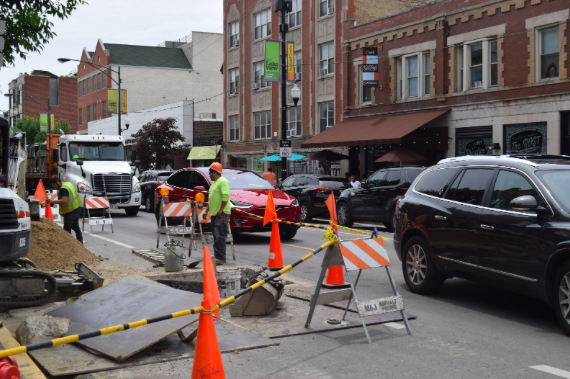
As a cyclist, a foreign object or disruption in the road is able to knock you off your path. Stay alert to any potential hazards in the road by scanning your surroundings. Chicago has more than its fair share of potholes and speed bumps, so it is important to be vigilant when scanning for obstacles.
Cycling can be a great way to get around the city, and following these guidelines can help keep you safe as well. But even the most responsible cyclists occasionally run into trouble. According to the CDOT Bike Crash report, the city of Chicago experiences an average of 1,500 cycling accidents each year.
If you or someone you know has been injured in a cycling accident, the lawyers at Strellis & Field can help. Our experienced lawyers have had great success representing the victims of cycling accidents and we are committed to helping you every step of the way in order to obtain the compensation that you deserve.
